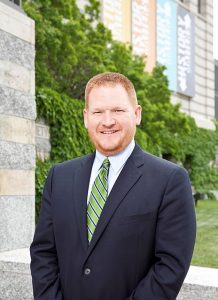by Lily Eisenthal
 When the Minnesota Legislature is in session from January to May each year, David Kelliher’s laptop bag becomes his office. As the Director of Government Relations and Public Policy for the Minnesota Historical Society (MNHS), he often finds himself making the short walk between the State Capitol building and the MNHS’s headquarters at the History Center multiple times a day. He stresses the importance of being present, because those who show up “get to participate, watch the process, and build relationships.” Building relationships with both legislators and their constituents is key in his work, which is all about advocating for public history in Minnesota and making sure that the Historical Society gets the funding that it needs to operate as a research center and museum and to maintain the 26 historic sites it manages across the state.
When the Minnesota Legislature is in session from January to May each year, David Kelliher’s laptop bag becomes his office. As the Director of Government Relations and Public Policy for the Minnesota Historical Society (MNHS), he often finds himself making the short walk between the State Capitol building and the MNHS’s headquarters at the History Center multiple times a day. He stresses the importance of being present, because those who show up “get to participate, watch the process, and build relationships.” Building relationships with both legislators and their constituents is key in his work, which is all about advocating for public history in Minnesota and making sure that the Historical Society gets the funding that it needs to operate as a research center and museum and to maintain the 26 historic sites it manages across the state.
Kelliher first visited the Minnesota State Capitol as a student at Carleton College, through a course he took with Paul Wellstone called State and Local Government that involved weekly field trips up to Saint Paul to watch the Legislature in action. He also discovered the Minnesota Historical Society during this time, conducting research in their archives for a seminar paper. After graduating from Carleton with a B.A. in history in 1986, Kelliher continued to explore his interests in both policy and history, working on a historic building survey in Illinois, taking a job as a staffer at the Minnesota Capitol, and eventually landing at the Minnesota Historical Society. He started out at MNHS developing programs and writing grants, but when the person who had been lobbying for their budget retired, the Historical Society asked Kelliher if he would take the position. He jumped at the chance and has been working in this unique role for twenty-some years since.
Kelliher says that each of these years has been different. In fact, not even two days in his job have been quite the same, but what it really boils down to is talking to people. He finds that being able to communicate clearly is a must. Crisp and informative writing is essential, whether he’s preparing materials for a formal presentation to legislators about one of the Historical Society’s capital projects or simply responding to an email from someone interested in the MNHS grant application process. Kelliher engages in a lot of what he calls “direct advocacy,” where he works directly with the government to promote the work of the MNHS. He notes that getting the message out can sometimes be challenging. There is a lot going on at the Capitol and it can be hard to get legislators’ attention. Kelliher likes to raise awareness and make connections with legislators by inviting them over to the History Center for behind-the-scenes tours or to check out programs at a historic site in their district. There is also a grassroots side to the work that he does, reaching out to people in communities across the state in order to create a network of people who care about public history and can in turn become advocates for the MNHS.
One of Kelliher’s biggest successes in both grassroots and direct advocacy came in November of 2008, when Minnesotans voted in favor of the Clean Water, Land, and Legacy Amendment. The amendment raised state sales taxes to set aside four funds, one of which is the Arts and Cultural Heritage Fund (ACHF). A portion of the ACHF is appropriated to the Historical Society each year, which they then use to administer a grants program and to fund programming, partnerships, and other projects. This unique piece of legislation is the result of years of planning, organizing, and coalition-building with the arts and outdoors communities. Kelliher says that in the past, grants had come in fits and starts, and that the Legacy Amendment allowed for a consistent stream of grant funding in the state. Kelliher is happy that Legacy funds have been accessed by a broader network than initially expected: he notes that community oral history projects have been just as popular as more traditional preservation or research projects at established institutions.
In closing our interview, I asked Kelliher if he had any advice for new cultural heritage professionals interested in outreach and advocacy work. He emphasized the importance of making an effort to understand your audience and how they see the world. Don’t talk past the people you are trying to reach, talk with them. Respectful conversations will help you find the best ways to connect people with resources that will enrich their lives.
